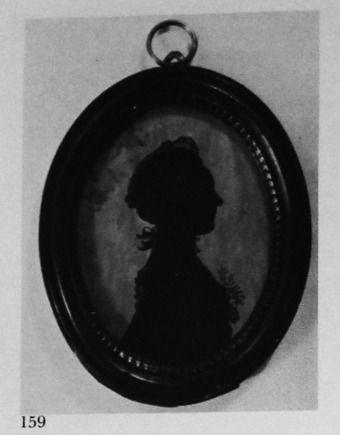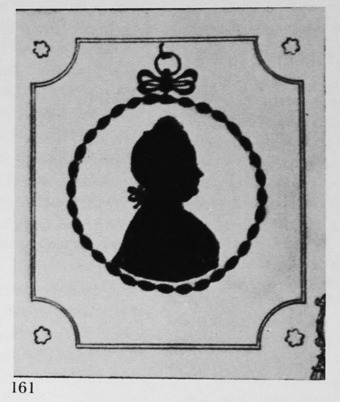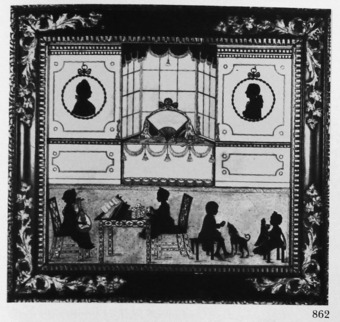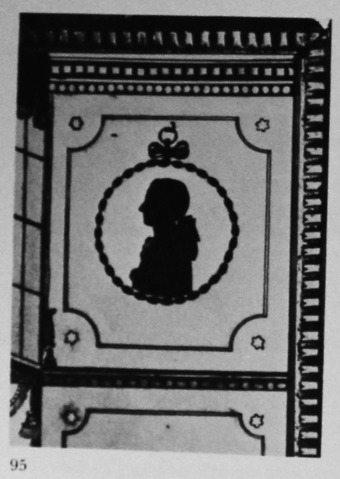Jolliffe, John (McKechnie Section 2)
See Section Three for main entry
By 1758 Jolliffe had produced at least eight hundred silhouettes, 'with a candle', he tells us (that is, by using a candle to throw the sitter's shadow onto a wall).
It is virtually certain, from the profile of Elizabeth Norman, that he was painting black silhouettes by 1762; this profile is dated 1762, and above the date, at the side of the profile near the base, is an indistinct signature which appears to read 'Jolliffe 1762'.
159
Jolliffe was certainly painting black work by c. 1767, the period when he painted (and partly cut) his large group silhouette of the Ashburnham family.
At Wilton House, near Salisbury, are a number of profiles painted in a style very much like that of the profile of Elizabeth Norman, and framed in exactly the same way. Since the silhouette of Elizabeth Norman is signed by Jolliffe, then the following silhouettes at Wilton House can also be ascribed to him:
The Earl of Clanbrassil 1776 (The Earl, an Irish peer, was son of the Earl of Roden. He inherited the Clanbrassil title from his mother).
Mr [David) Garrick 1775
Mrs Garrick 1775
Lord William Gordon 1777
Comte de Guines 1775 (inscribed on the reverse 'The French Ambassador')
Mr Godeshall Johnson 1777
Duc de Langue 1778
Charles Medows 1777
'A. R. Reebkomp' 1778. (The sitter, a young man, born in 1762, was a member of the family of the Earl of Pembroke, whose seat was, and
remains, at Wilton House. 'Reebkomp' is an anagram of Pembroke.)
Mr Ralph Sheldon 1776
An unknown woman (The words 'Green Room' are inscribed on the front of the silhouette.)
Jolliffe's most important painted work is embodied in his group silhouette of the Ashburnham family, taken almost certainly in the nursery at Ashburnham House in Dover Street, London. The sitters, their costume and their surroundings in this rare and early example of silhouette art (almost certainly painted in 1767, and probably in its original frame) merit extended discussion.
All the work is painted except for the portraits of the children and the dog, which were cut and stuck to the finished picture. This is clear not only from the 'halo' created by the gum which surrounds these profiles, but also because the heads of two of the girls protrude a little too high against the dado on the nursery wall. The sitters are John, Second Earl of Ashburnham, and members of his family. The bust-length profiles of the Earl and Countess are shown as painted portraits on the wall panels. The sitters are as follows. In the panel at top-left is the Countess of Ashburnham; born Elizabeth, daughter and co-heiress of Alderman Crawley, of London, she married John, Second Earl of Ashburnham on 28 June 1756 and died in 1812. In the panel at top-right is John, Second Earl of Ashburnham, LL D, born on 30 October 1724. In 1753 he was appointed Keeper of Hyde Park and of St James's Park, and, in 1775, First Lord of the Bedchamber and Groom of the Stole to George III. The girl at far left is Henrietta Theodosia, daughter of the Earl and Countess, born in c. 1759, who died on 30 March 1847. She is shown playing the lute. The girl in the centre is another daughter, Jemima Elizabeth, born in c. 1763. She is shown building a house of cards. In 1785 she married James, Marquess of Graham, Duke of Montrose, KG. She died in the following year. Seen playing with the dog is the son of the family, George, later Third Earl of Ashburnham, born on Christmas Day, 1760. He married, first, on 28 August 1784, Sophia, third daughter of Thomas, First Marquis of Bath. Sophia died in 1791. On 25 July 1795 he married Charlotte, eldest daughter of Algernon, First Earl of Beverley; she died on 26 November 1862. Their son Bertram became the Fourth Earl of Ashburnham. The small girl on the right is Elizabeth Frances, born in c. 1765 and aged about two years when this portrait was executed. She died on 16 April 1854.
From the point of view of dating other silhouettes of the period, all the clothing shown on this silhouette is of much interest, since the date is earlier than that of most known family groups. (Details from the silhouette, showing single figures, are illustrated in Chapters Four, Six and Eight). All the furniture is painted with considerable care, and is of incidental interest in that it shows how a nursery was equipped during the 1760s.
95, 161, 227
At Windsor Castle there is a large portrait of Frederick, Prince of Wales, painted in bust-length and possibly Jolliffe's work. It is a full-length silhouette, 15 x 11 in., and, if not posthumous, was painted before the death of the Prince in 1751.
The profile of Elizabeth Norman, already referred to, is painted much in the plain black style of the profiles of the Earl and Countess Ashburnham in the group silhouette. It appears to be painted in black water-colour, which was probably the medium in which the background of the Ashburnham group was painted also.
Since the Ashburnham group bears Jolliffe's Trade Label no. 1, we know that the artist was using a printed trade label as early as 1767. With regard to his signatures, it is evident from his profile of Elizabeth Norman that Jolliffe signed small profiles of this type on the side near the bottom, as did many portrait miniaturists of the time.
Ills. 95, 159, 161, 862

Miss Elizabeth Norman
Silhouette painted on paper by W. J. Jolliffe, 1762.
costume dating points
The hair drawn up from the back, and back from the front of the head.
The Pulteney cap, whose shape is clearly shown.
The bosom-knot, which probably indicates the presence oaf a bosom-bottle as well.
The line at the back of the silhouette suggests the sack dress, which was very popular at the time. The other detail at the back suggests that the sitter is wearing a handkerchief.
The ribbon necklace, tied at the back.
Author’s collection

Countess Ashburham. Detail from a silhouette of John, second Earl of Ashburnham, and his family (859), by W. J. Jolliffe, possibly 1767.
costume dating points
This is probably the small round cap of the time, worn tilted forward, with peaks near the forehead which would show on a silhouette.
The line at the back suggests the sack worn at the time.
The ribbon necklace, tied at the back.
By courtesy of the Reverend John D. Bickersteth
SECTION TWO

John, second Earl of Ashburnham, and his family
Group of silhouette painted on card, partly cut
? 1767
Trade Label No. 1
By courtesy of the Reverend John D. Bickersteth

John, second Earl of Ashburnham.
Detail from a silhouette (859) of the earl and his family by W. J. Jolliffe, c. 1767. (See 161 for another detail from this silhouette, showing the countess of Ashburnham).
costume dating points
The large bag wig, very fashionable during this decade, and still worn by some men in the 1770s.
The pre-1785 stock, without bows.
By permission of the Reverend John D. Bickersteth
Chapter 6
